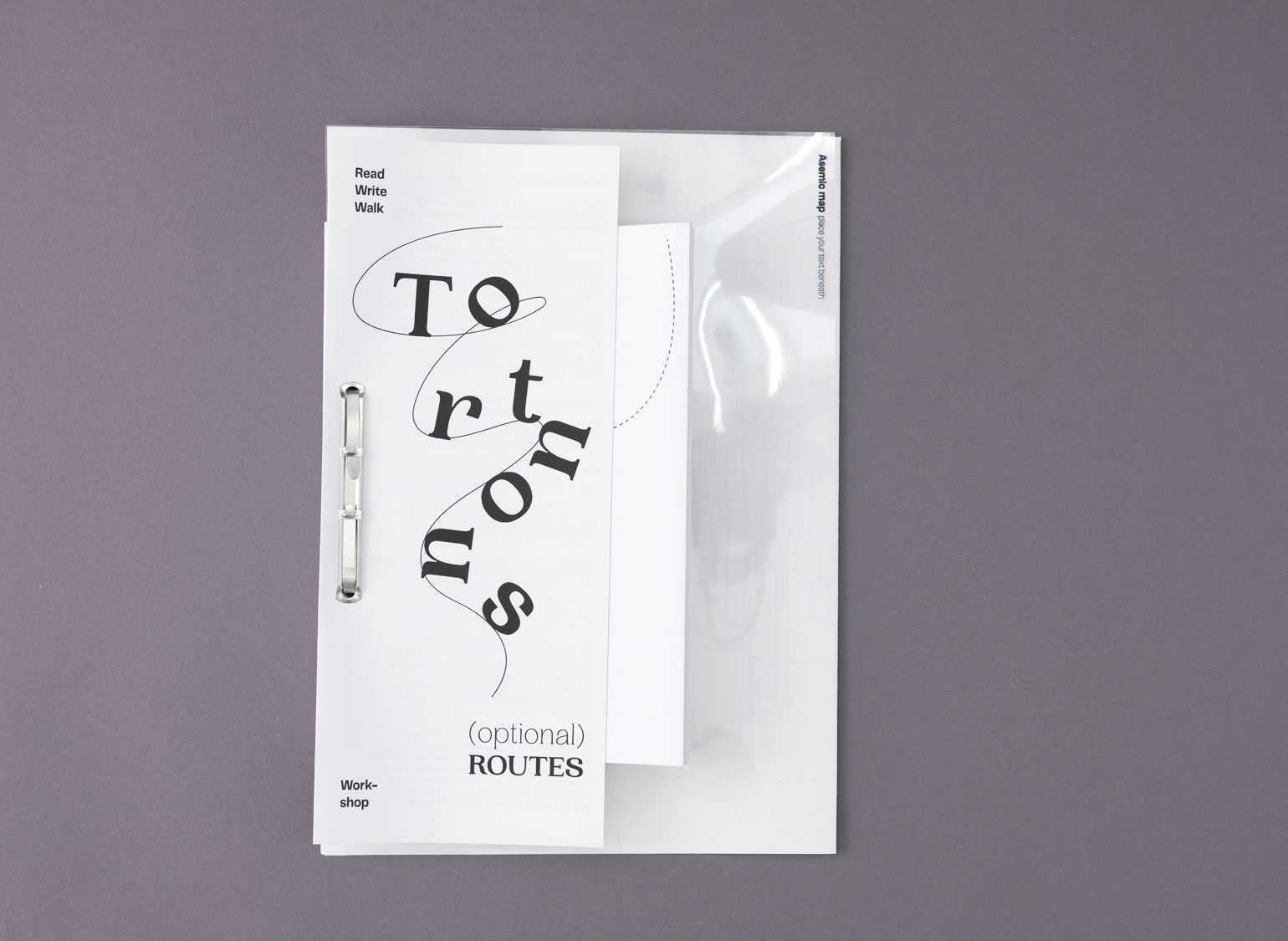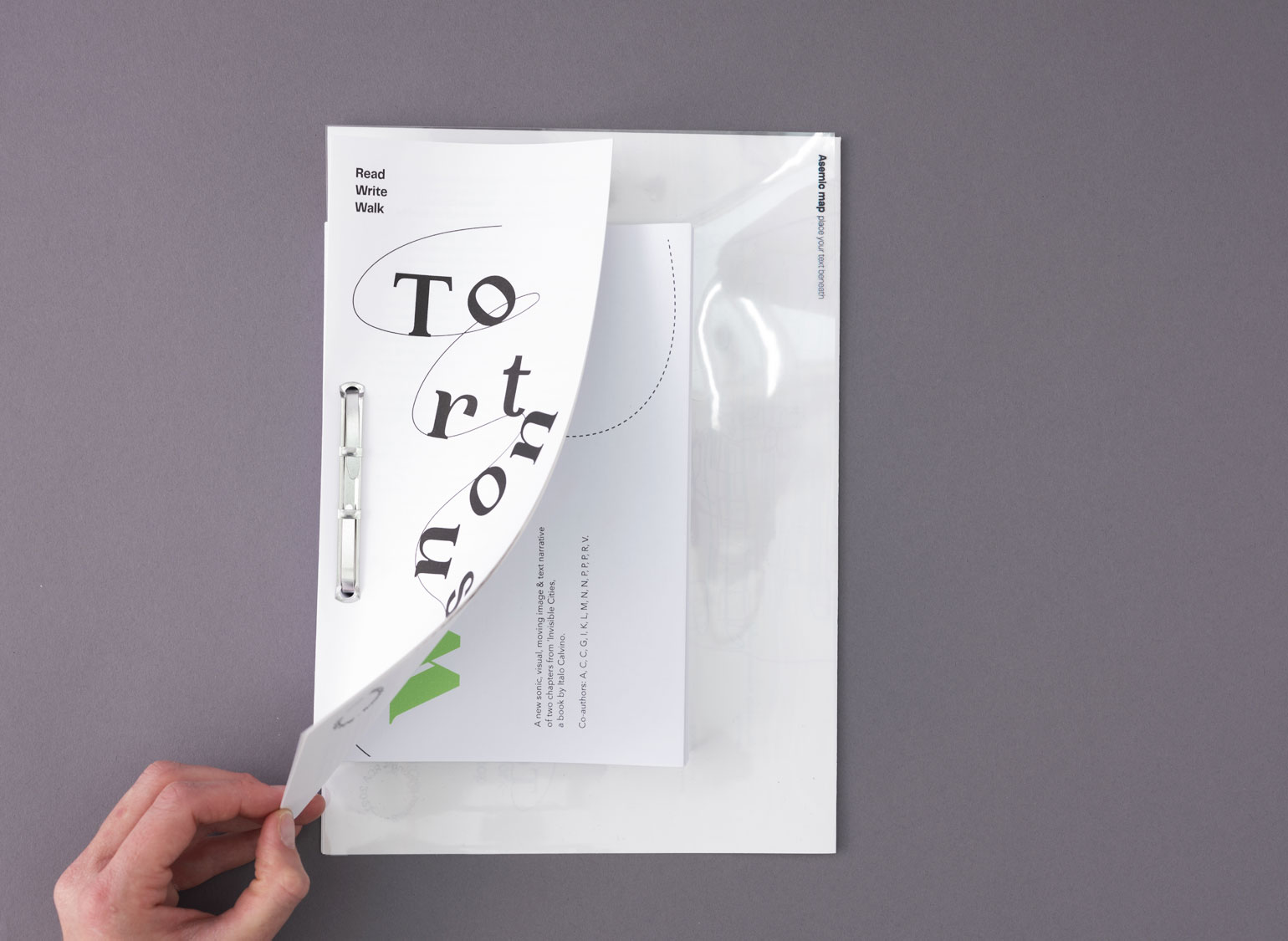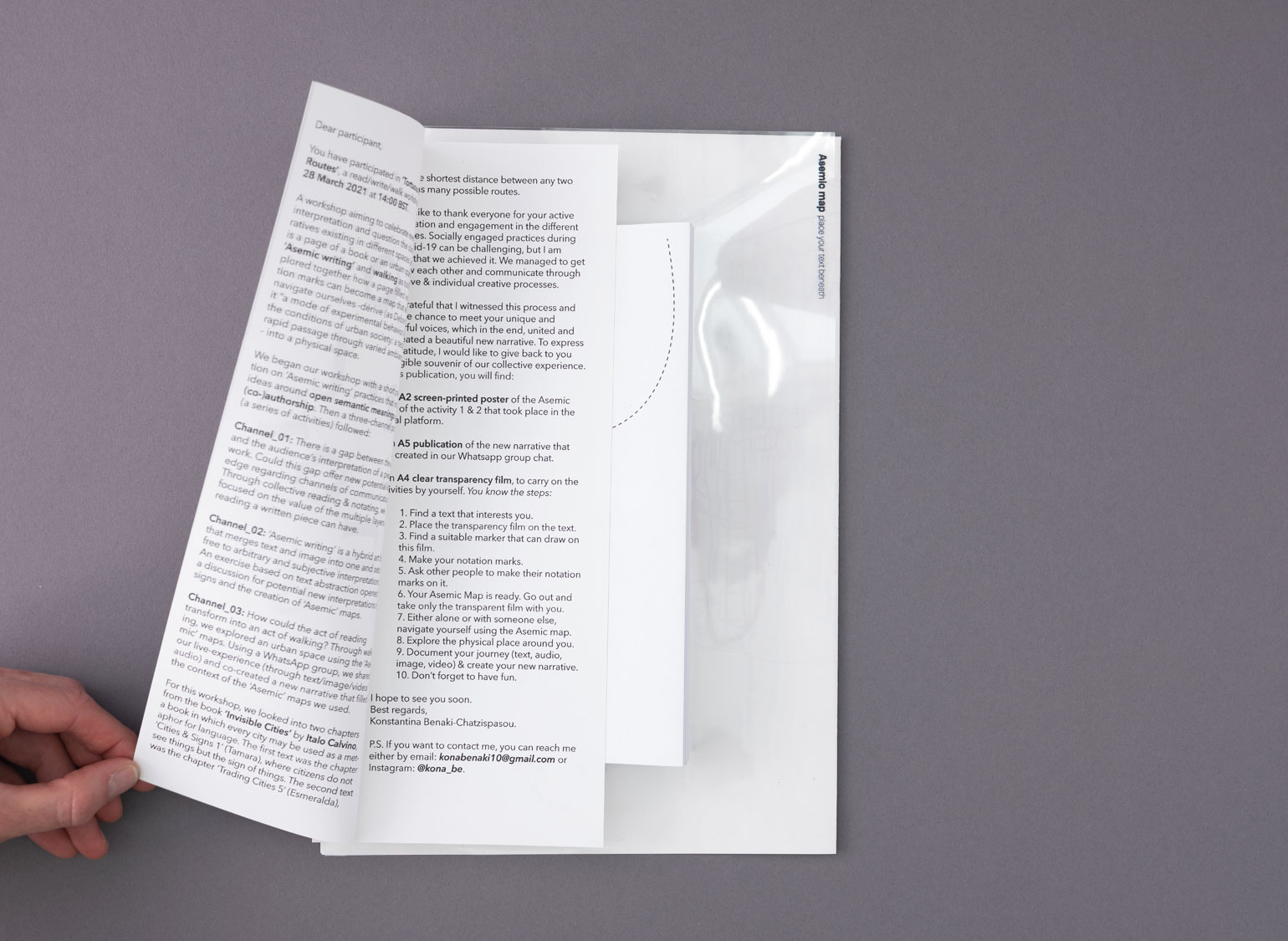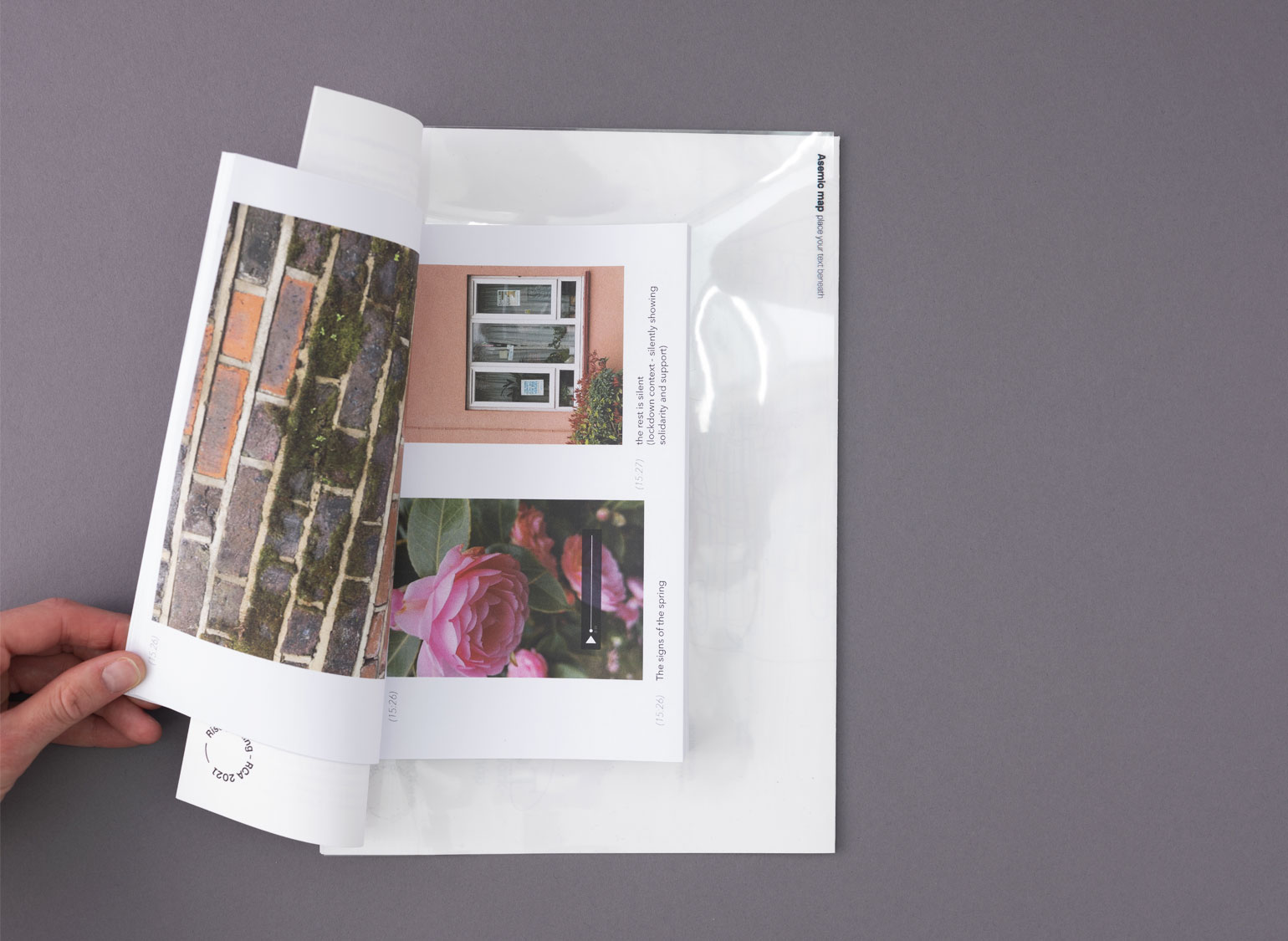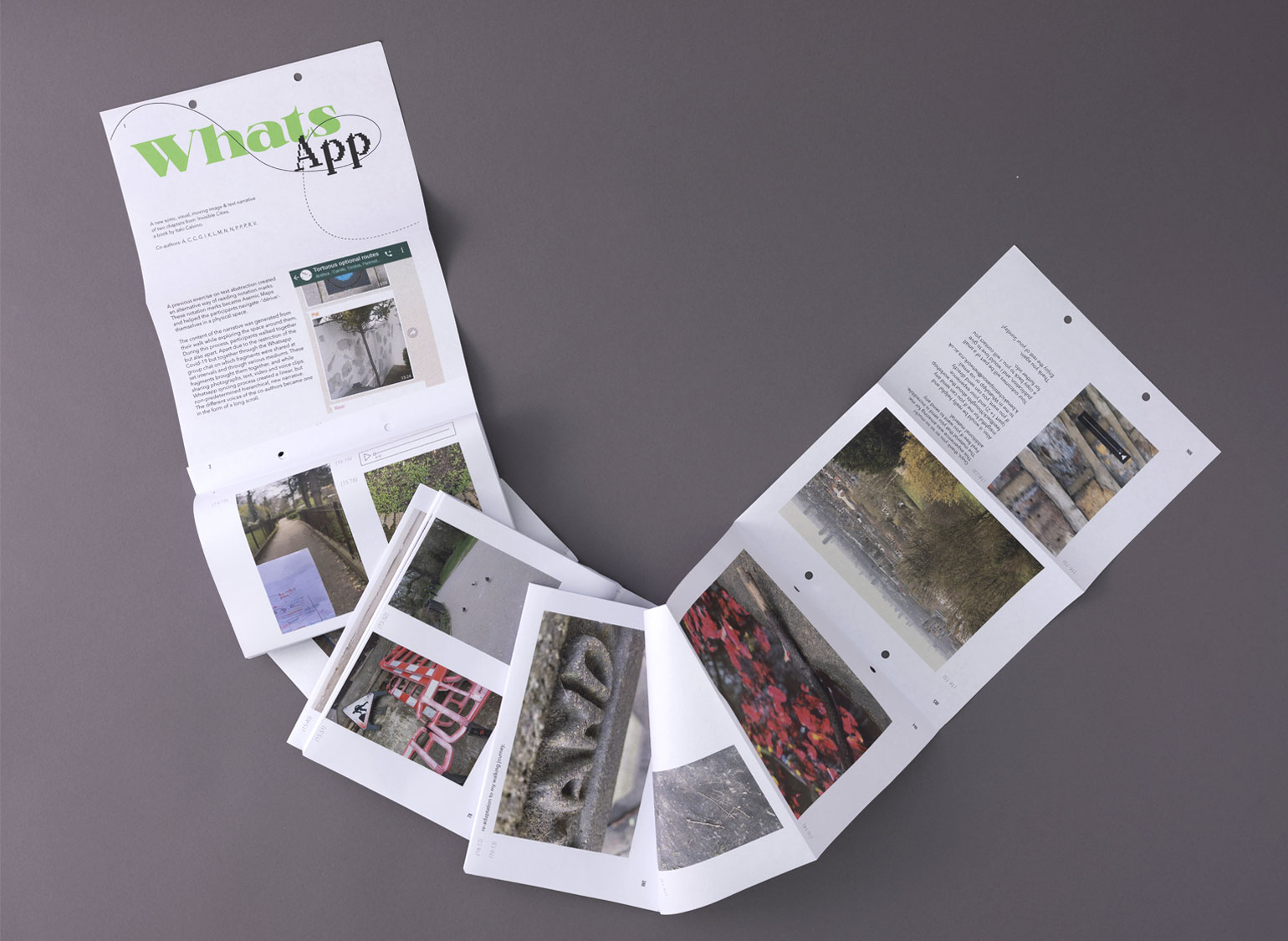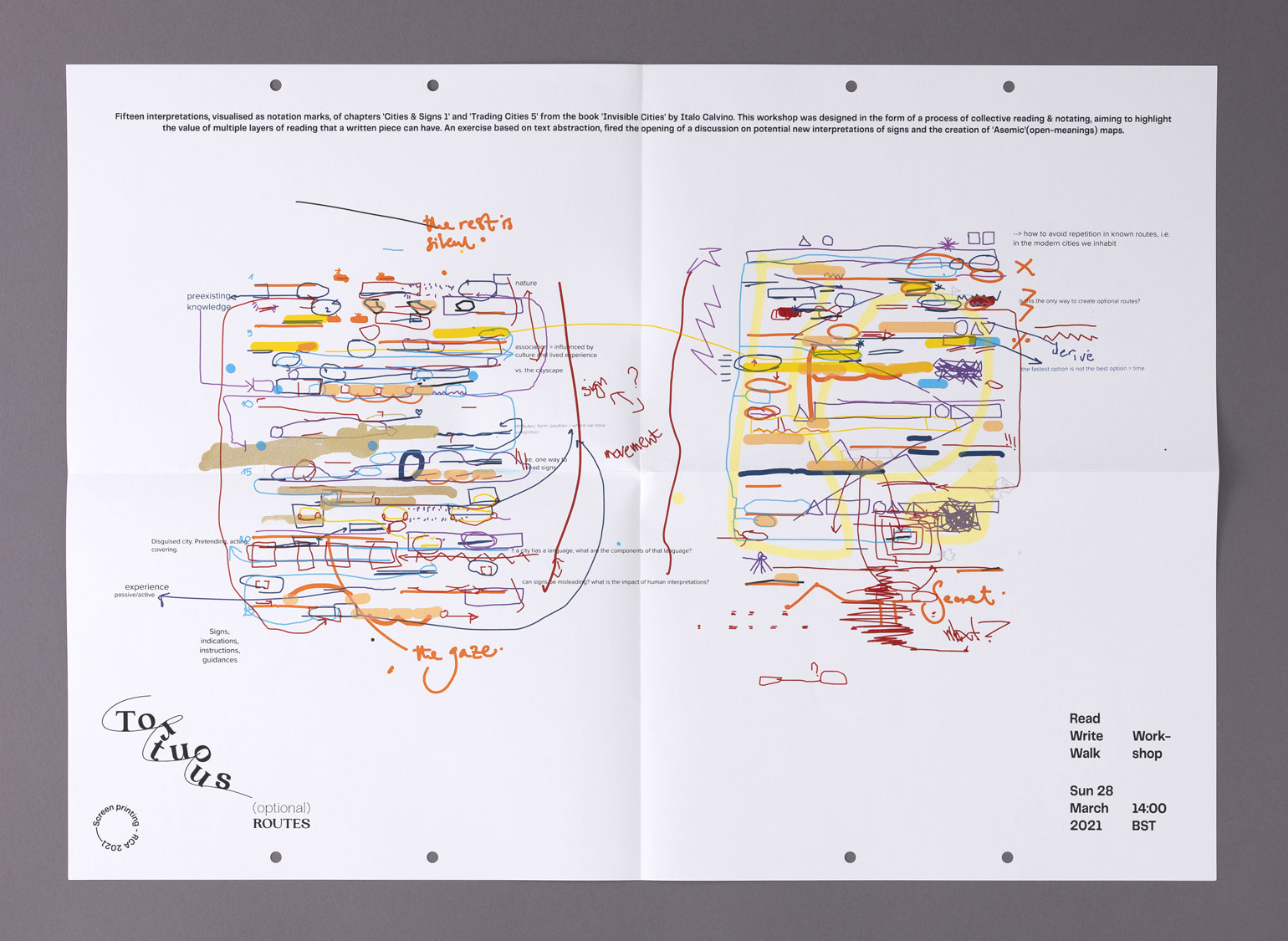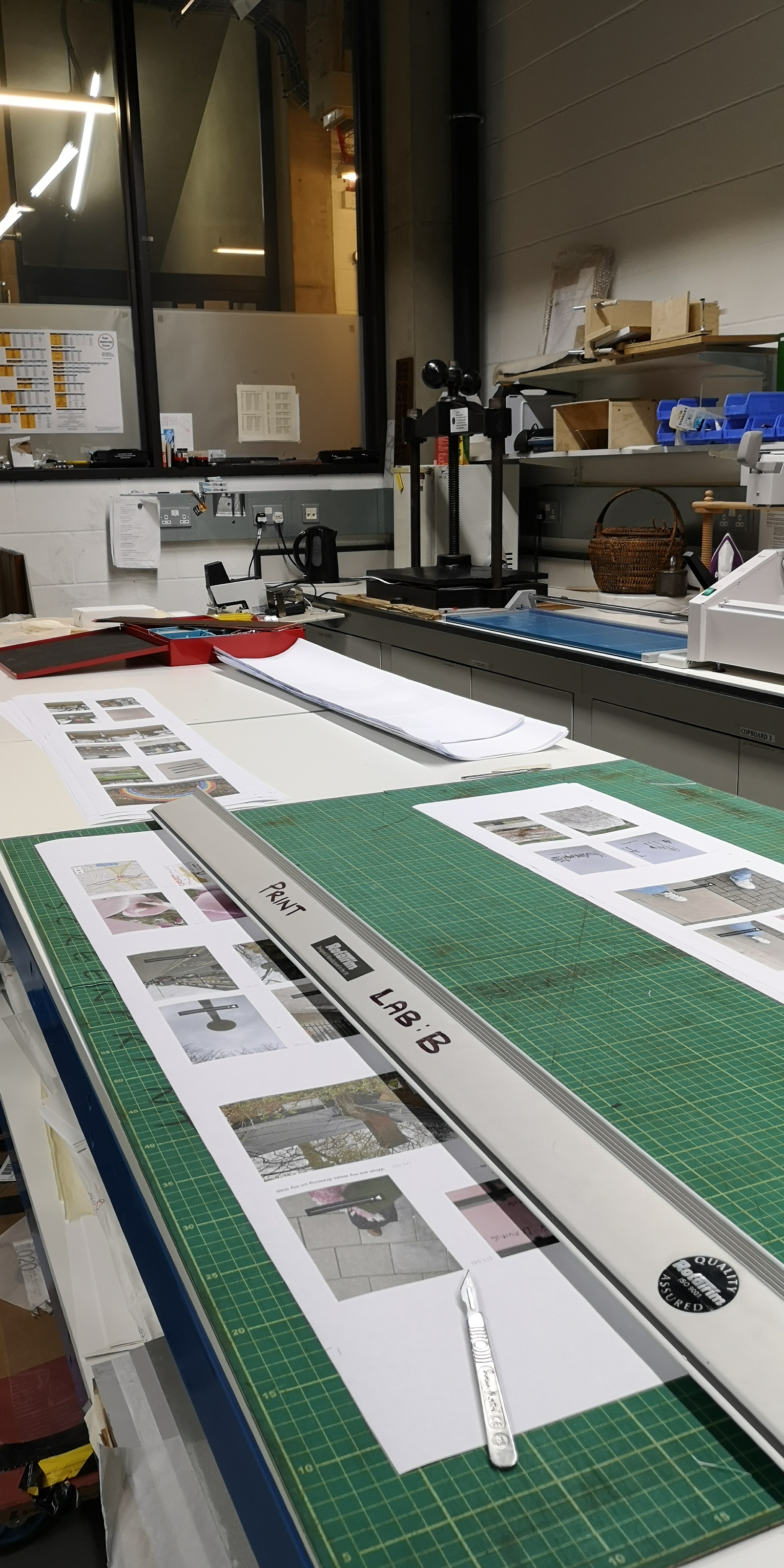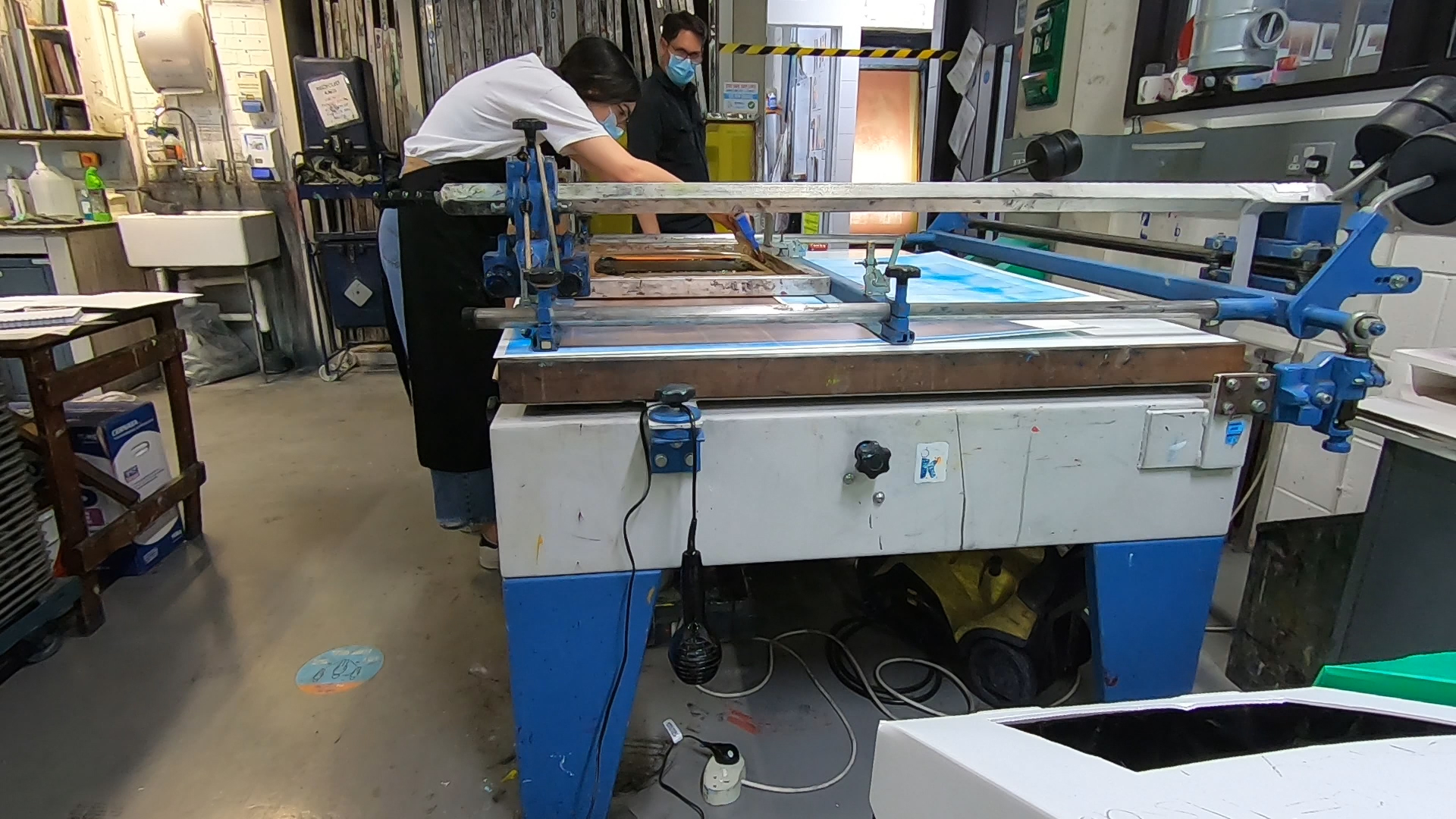Tortuous Optional Routes is a workshop aiming to celebrate every reader's interpretation and question the dominant narratives existing in different spaces (whether this is a page of a book or an urban space) using Asemic writing and walking as tools.
The workshop is based on and includes two specific texts which correspond
to the idea of dominant & multiple narratives and the idea of an open-meaning map that can suggest undiscovered optional routes.
The two specific texts are two chapters from the book 'Invisible Cities' by Italo Calvino, a book in which every city may be used as a metaphor for language. The first text was the chapter 'Cities & Signs 1' (Tamara), where citizens do not see things but the sign of things. I specifically selected this chapter because it describes and criticises perfectly how dominant narratives(signifiers) exist everywhere, in every object, building, space and event - making it challenging to discover what is beyond all these and what we want to see.
The second text was the chapter 'Trading Cities 5' (Esmeralda), where the shortest distance between any two points has many possible routes. Passersby are immersed in the labyrinth of streets of Esmeralda, with infinite possibilities of reading their routes, so there is no repetition. This idea reminds me of Guy Debord's notion of psychogeography and dérive, which advocates the act of becoming lost in the city. An act of resistance in walking with an agenda from point A to point B and a way to explore and absorb different aspects of the urban life world.
The two specific texts are two chapters from the book 'Invisible Cities' by Italo Calvino, a book in which every city may be used as a metaphor for language. The first text was the chapter 'Cities & Signs 1' (Tamara), where citizens do not see things but the sign of things. I specifically selected this chapter because it describes and criticises perfectly how dominant narratives(signifiers) exist everywhere, in every object, building, space and event - making it challenging to discover what is beyond all these and what we want to see.
The second text was the chapter 'Trading Cities 5' (Esmeralda), where the shortest distance between any two points has many possible routes. Passersby are immersed in the labyrinth of streets of Esmeralda, with infinite possibilities of reading their routes, so there is no repetition. This idea reminds me of Guy Debord's notion of psychogeography and dérive, which advocates the act of becoming lost in the city. An act of resistance in walking with an agenda from point A to point B and a way to explore and absorb different aspects of the urban life world.


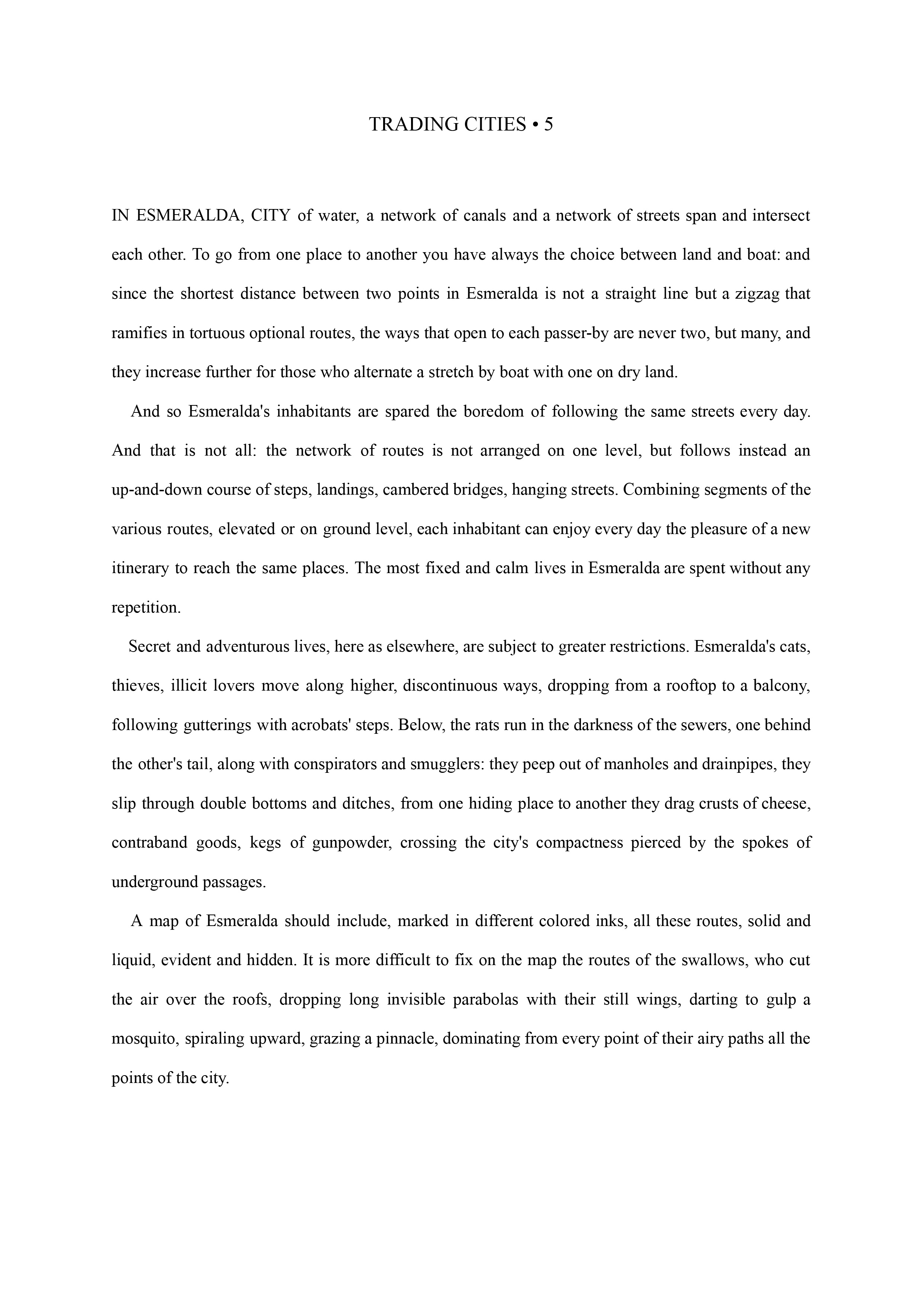
We began our workshop with a short introduction on Asemic writing practices that introduce ideas around open semantic meanings and (co-)authorship. Then a three-channel series of activities followed:
Activity 1:
Collective Reading & Annotating
In the first activity, we focused on the value of the multiple layers of reading a written piece can have. The workshop took place on the Mural platform, which allows us to be in space altogether and understand others' presence. Every participant had to select a specific colour of a pen tool and make notes as they read the texts. Each action was transparent and could be traced. Having the option to be anonymous or having a nickname transformed this room into a less aggressive and more friendly environment where people had the freedom to express themselves as they wanted. Despite the fact that everyone was in their room, in another place of London, seeing other people's active cursors gave the sense that the room was full of life.
Exploring ideas around collectivity, I was curious to test how people react to be 'together' while reading and making notes on the same text. This sense of togetherness was visible from the simultaneous activity of the cursors and the pen tools that they used to make notations. The main feedback that I received from the participants was that they had a new and unique experience. Taking notes is something that usually is a high individualistic action. Exposing yourself and seeing other people make notes with you opens up the boundaries of this private action. People start looking at what the other person is doing. They found it interesting if someone was making similar notes under the exact phrase and sharing the same ideas, but also exciting to see how people reacted differently to other words.
The reading from a linear reading perspective becomes a web where you can read it from different ways. You become aware of this interactivity. Some of them drew notations around other participants' notes, or on them, or under them, or continued something from the point that someone left it. After a while, you lose the point of who comes first and who is behind each interpretation. The different layers of reading are blended, creating non-hierarchical, heterogeneous, multiplicitous, and acentered writings, as Deleuze and Guattari coined the term, a rhizomorphic reading.
Exploring ideas around collectivity, I was curious to test how people react to be 'together' while reading and making notes on the same text. This sense of togetherness was visible from the simultaneous activity of the cursors and the pen tools that they used to make notations. The main feedback that I received from the participants was that they had a new and unique experience. Taking notes is something that usually is a high individualistic action. Exposing yourself and seeing other people make notes with you opens up the boundaries of this private action. People start looking at what the other person is doing. They found it interesting if someone was making similar notes under the exact phrase and sharing the same ideas, but also exciting to see how people reacted differently to other words.
The reading from a linear reading perspective becomes a web where you can read it from different ways. You become aware of this interactivity. Some of them drew notations around other participants' notes, or on them, or under them, or continued something from the point that someone left it. After a while, you lose the point of who comes first and who is behind each interpretation. The different layers of reading are blended, creating non-hierarchical, heterogeneous, multiplicitous, and acentered writings, as Deleuze and Guattari coined the term, a rhizomorphic reading.

Activity 2:
Creation of Asemic Maps
For the second part of the workshop, I introduced them to the exercise of text abstraction to create an alternative way of reading notation marks. These notation marks became Asemic Maps and helped the participants navigate -drift- themselves in a physical space.
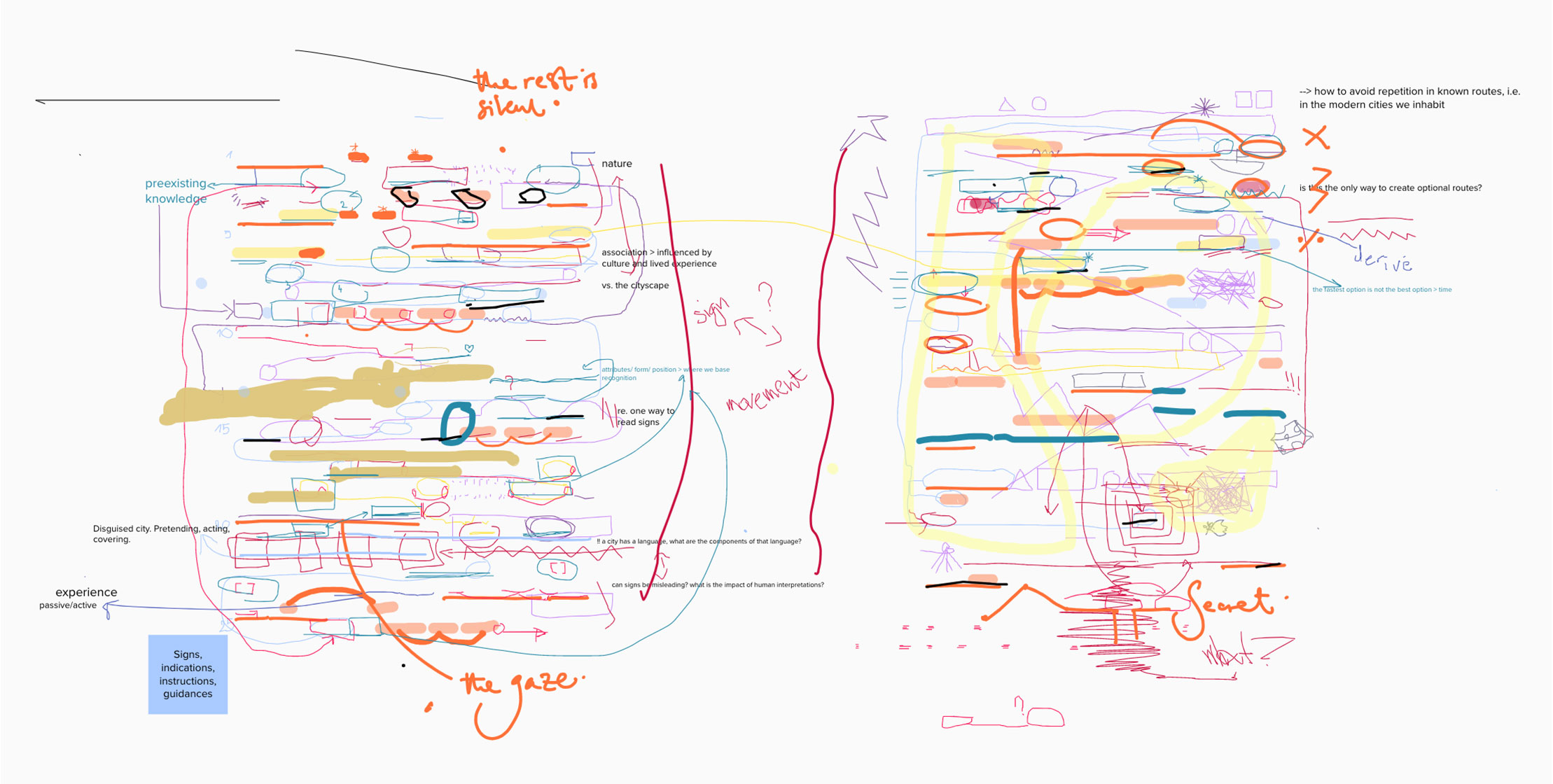
Activity 3:
Walking & sharing experiences
In the third activity, we tried to transform the act of reading into the act of walking. I asked the participants to print or screen-print the Asemic Maps and step out of their house. Through walking, we had to explore the urban space around us using this map. Using a WhatsApp group, we shared our (live)experience and co-created a new narrative.
The content of the narrative was generated from our walk while exploring the space around us. During this process, we walked together but also apart. Αpart due to the restriction of the Covid-19 but together through the Whatsapp group chat on which fragments were shared at set intervals and through various mediums. These fragments brought them together, and while sharing photographs, text, video and voice clips, Whatsapp syncing process created a linear, but non-predetermined hierarchical, new narrative. The different voices of the co-authors became one in the form of a long scroll.
People found different ways to interpret the Asemic Maps and connect these threads with the reality around them. For many, there was a progression in this process. They started to make easy connections between the colours or shapes between the map and the real world. But as they moved further, they moved into a more architectural and mathematical organisation. Some of them, in the end, moved into sound, ambiences and atmospheres. From simple to more complicated and layered connections. In this process, they perceive the environment as moving along, taking different routes and discovering new signs and narratives around them.
The content of the narrative was generated from our walk while exploring the space around us. During this process, we walked together but also apart. Αpart due to the restriction of the Covid-19 but together through the Whatsapp group chat on which fragments were shared at set intervals and through various mediums. These fragments brought them together, and while sharing photographs, text, video and voice clips, Whatsapp syncing process created a linear, but non-predetermined hierarchical, new narrative. The different voices of the co-authors became one in the form of a long scroll.
People found different ways to interpret the Asemic Maps and connect these threads with the reality around them. For many, there was a progression in this process. They started to make easy connections between the colours or shapes between the map and the real world. But as they moved further, they moved into a more architectural and mathematical organisation. Some of them, in the end, moved into sound, ambiences and atmospheres. From simple to more complicated and layered connections. In this process, they perceive the environment as moving along, taking different routes and discovering new signs and narratives around them.
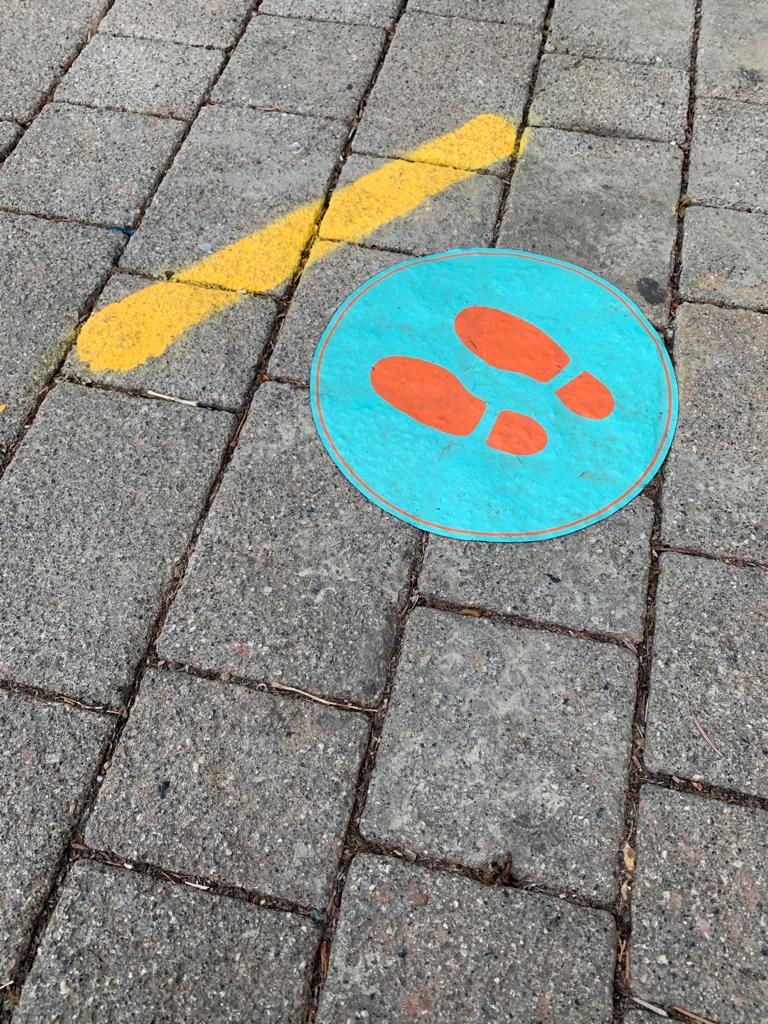


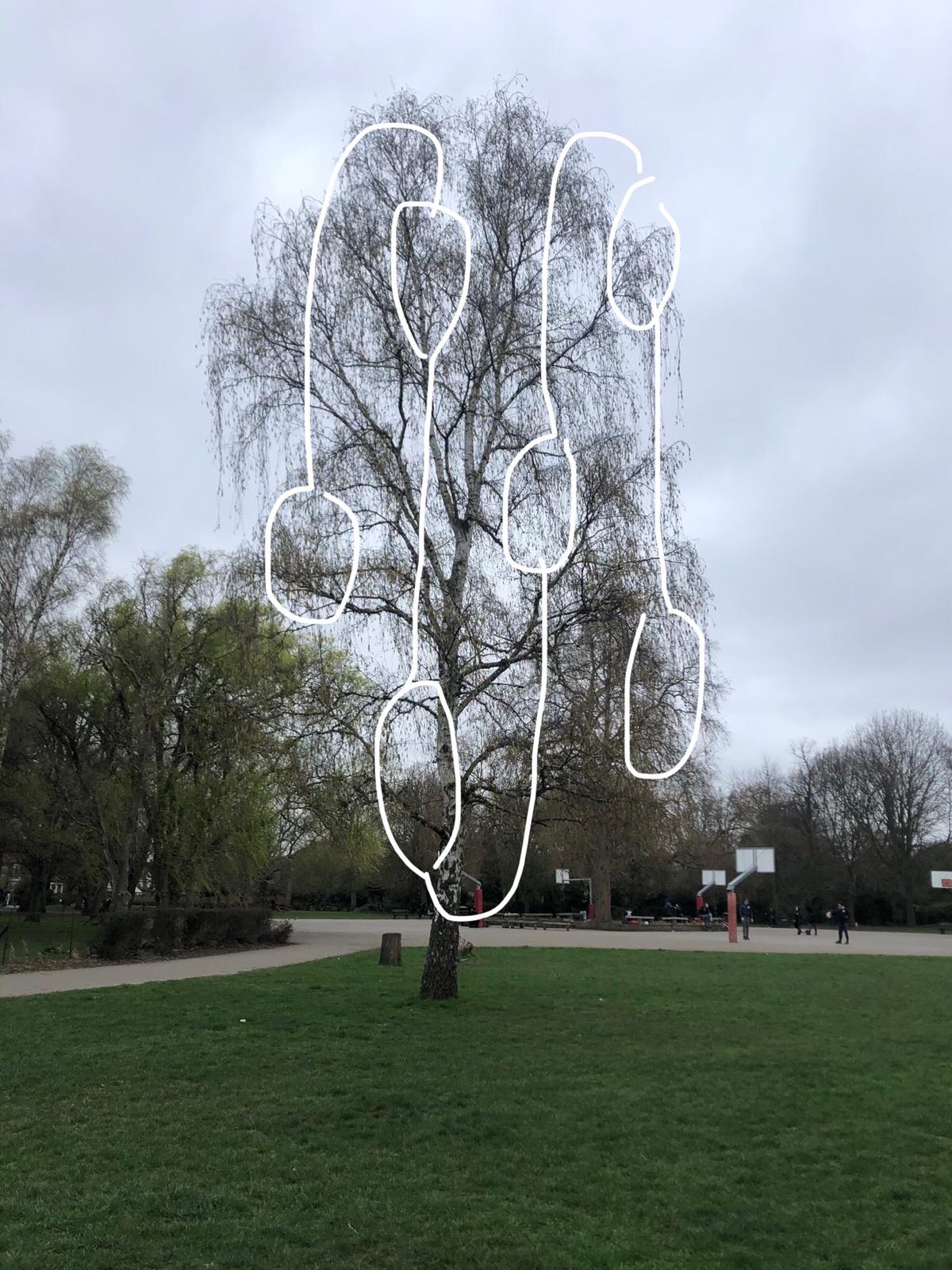
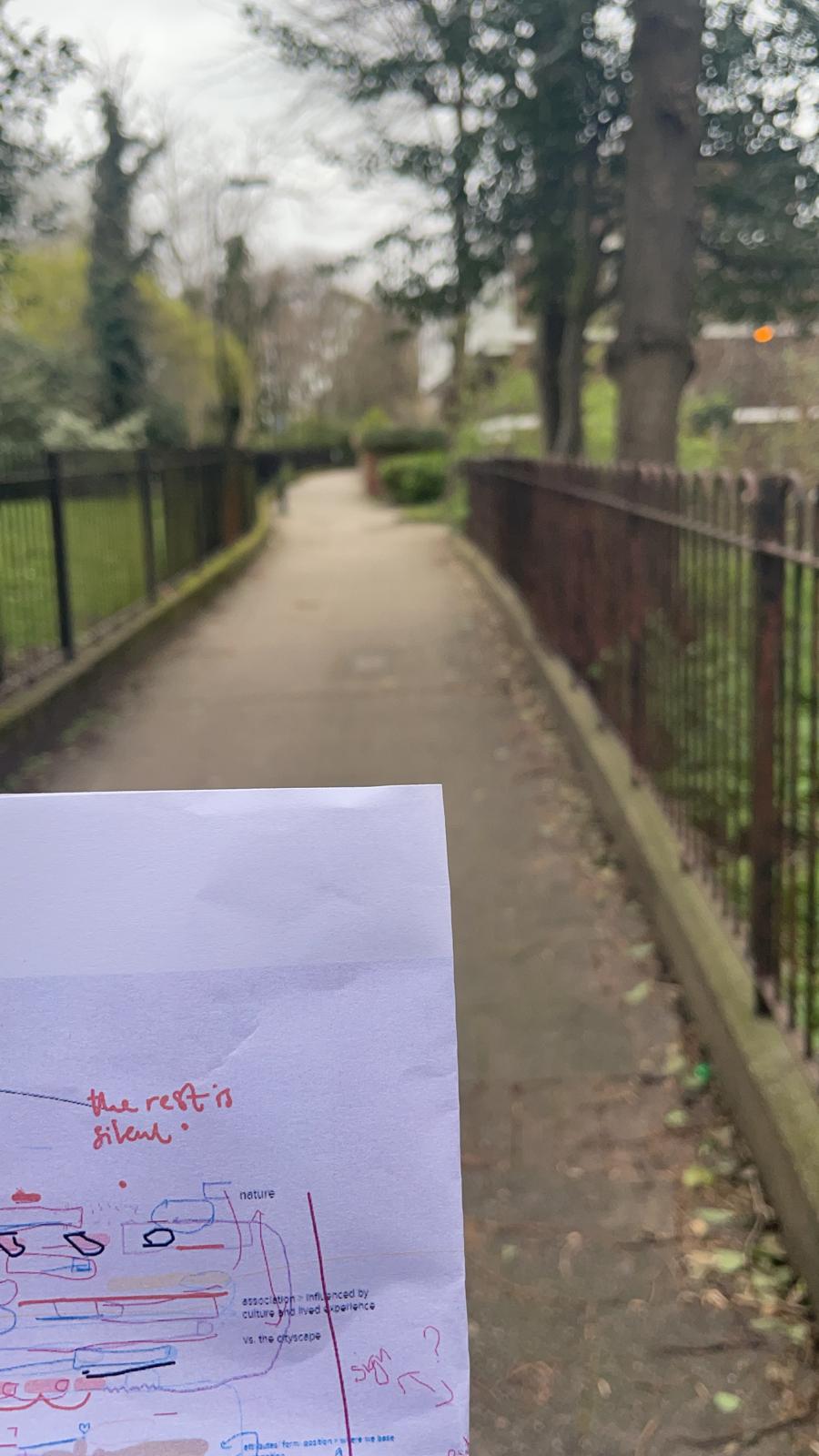

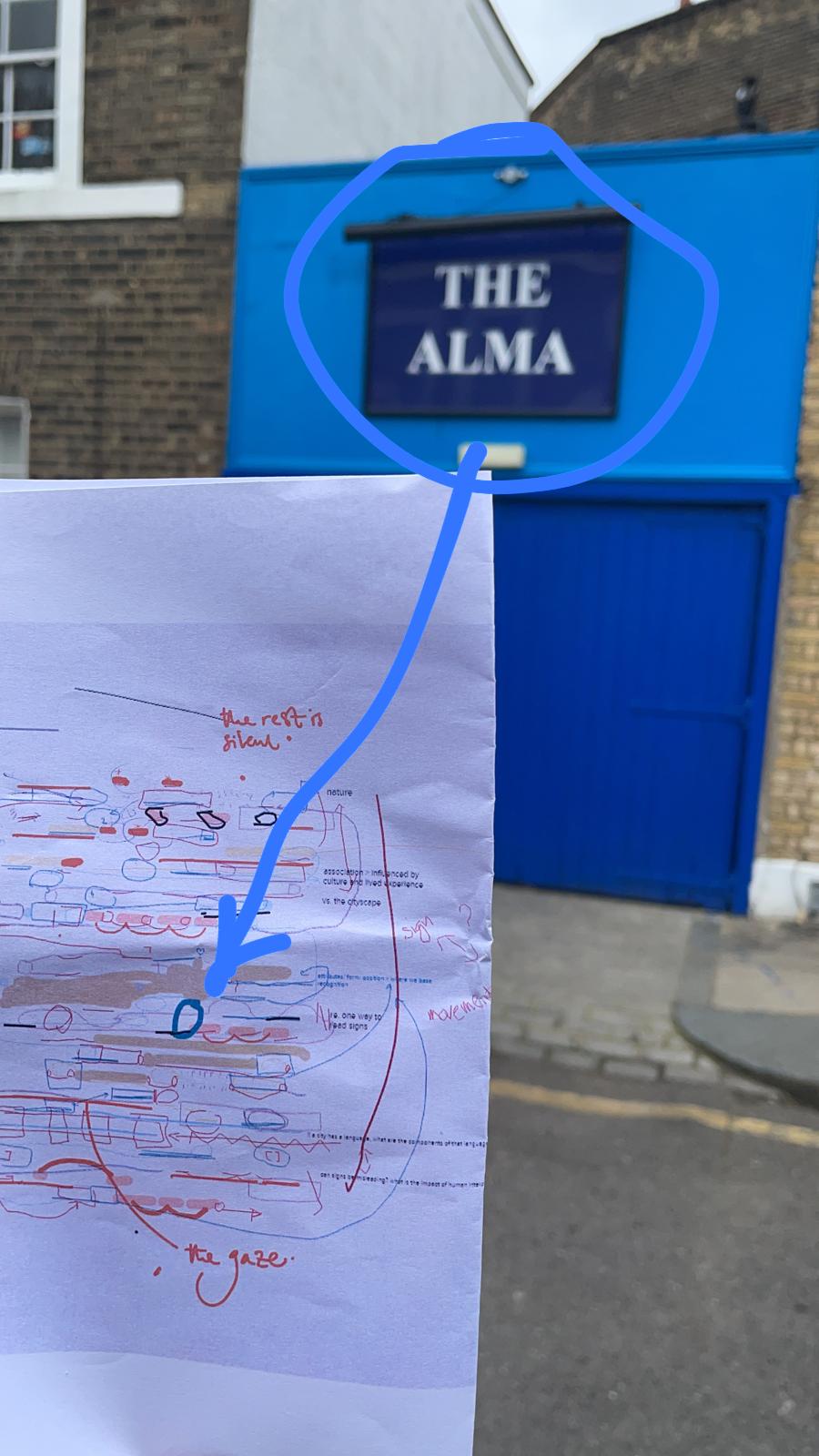

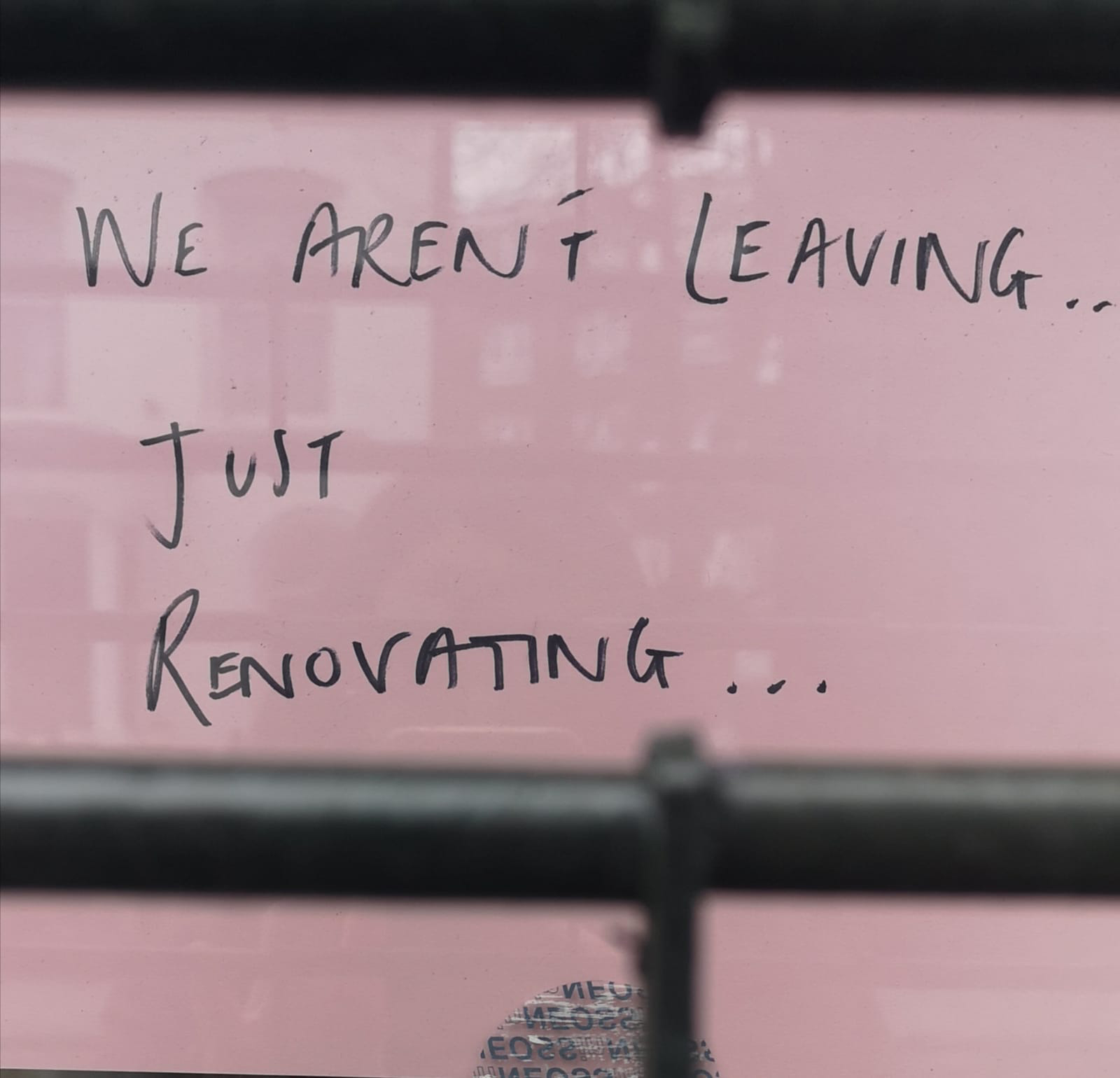
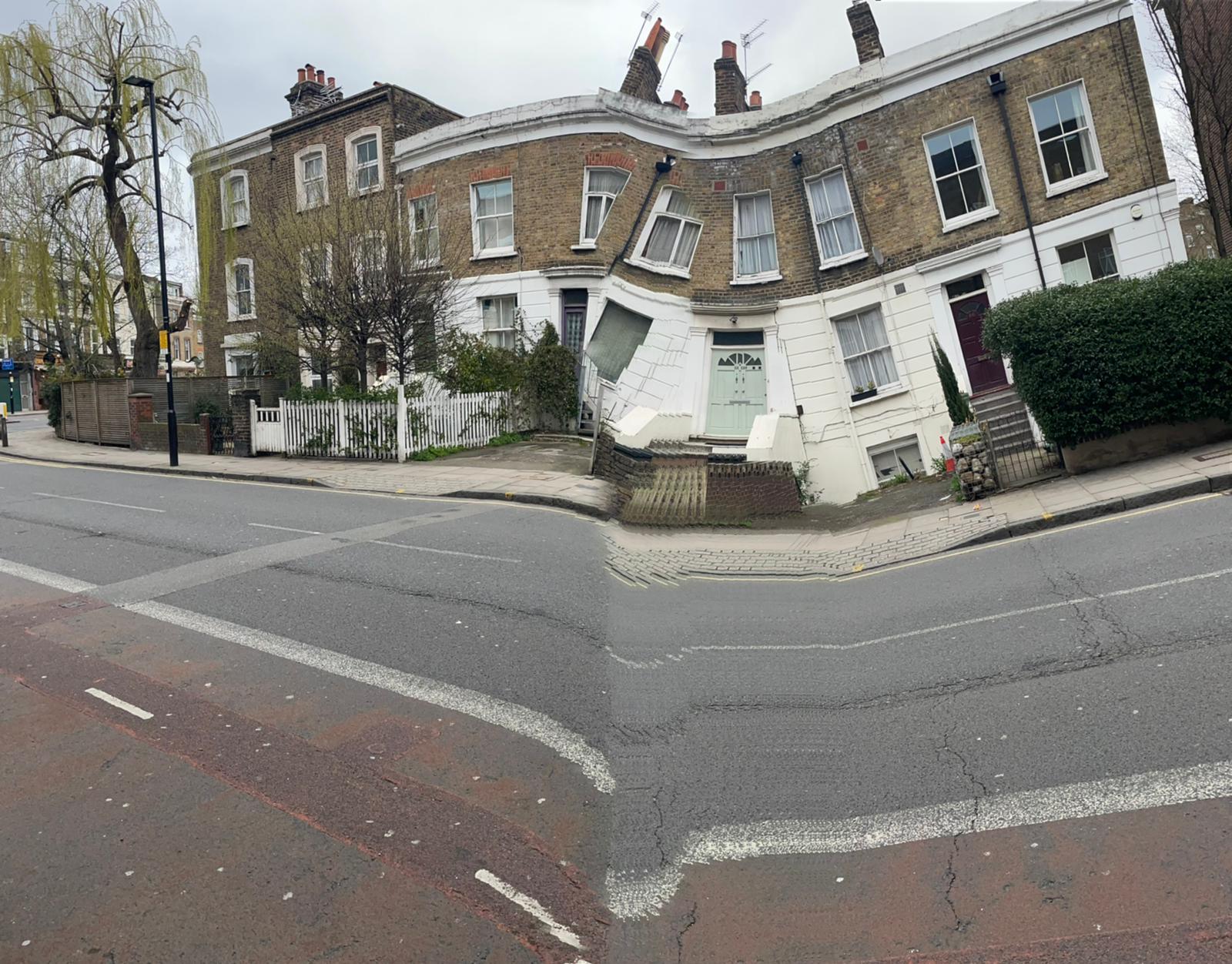
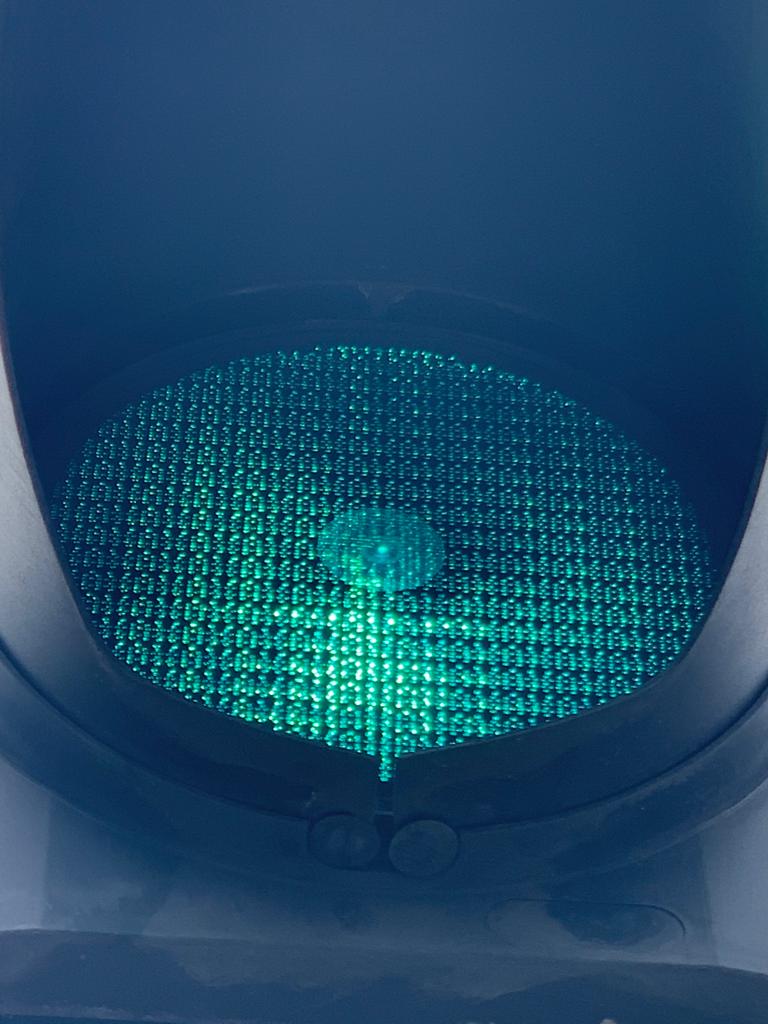
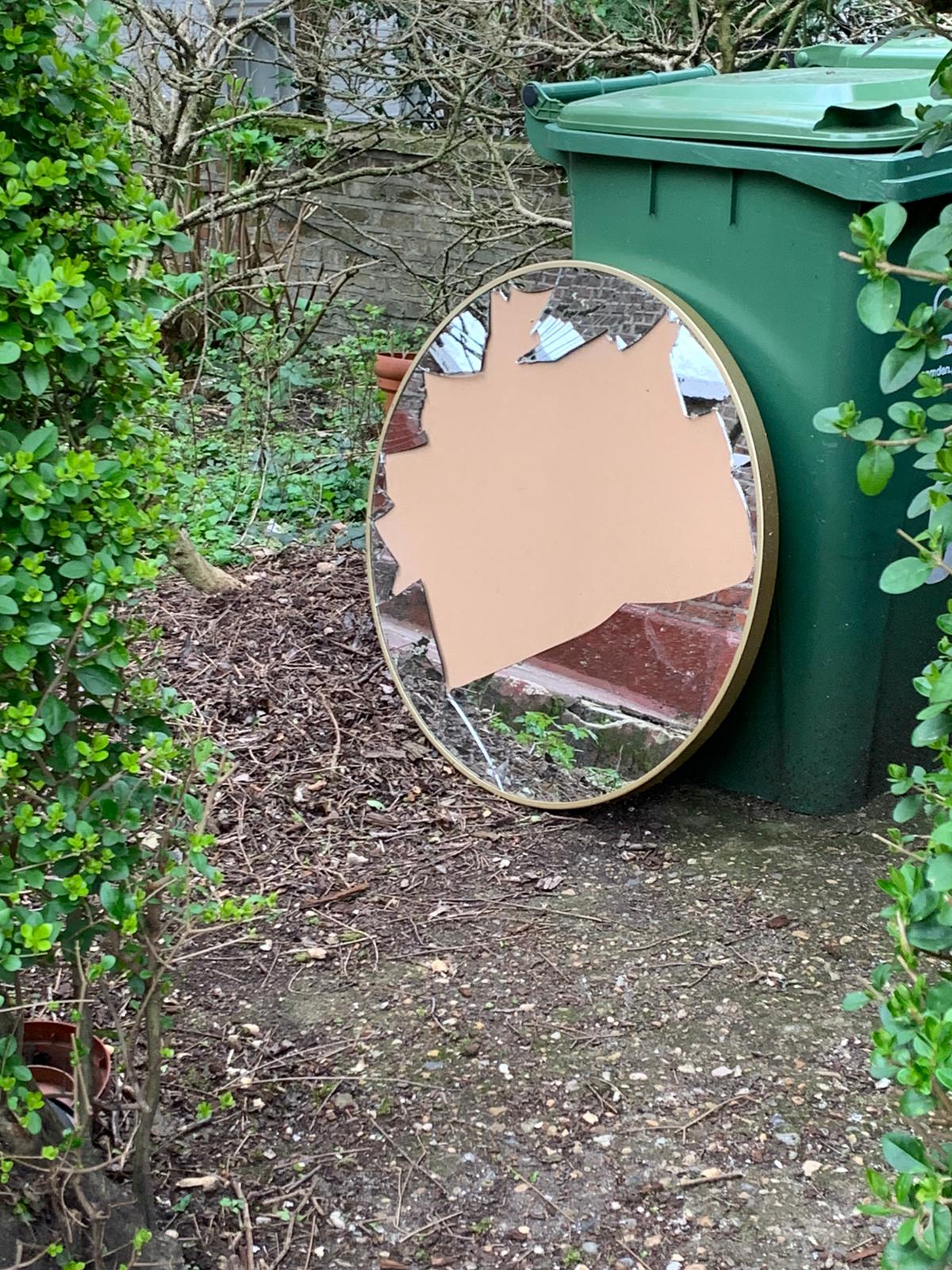

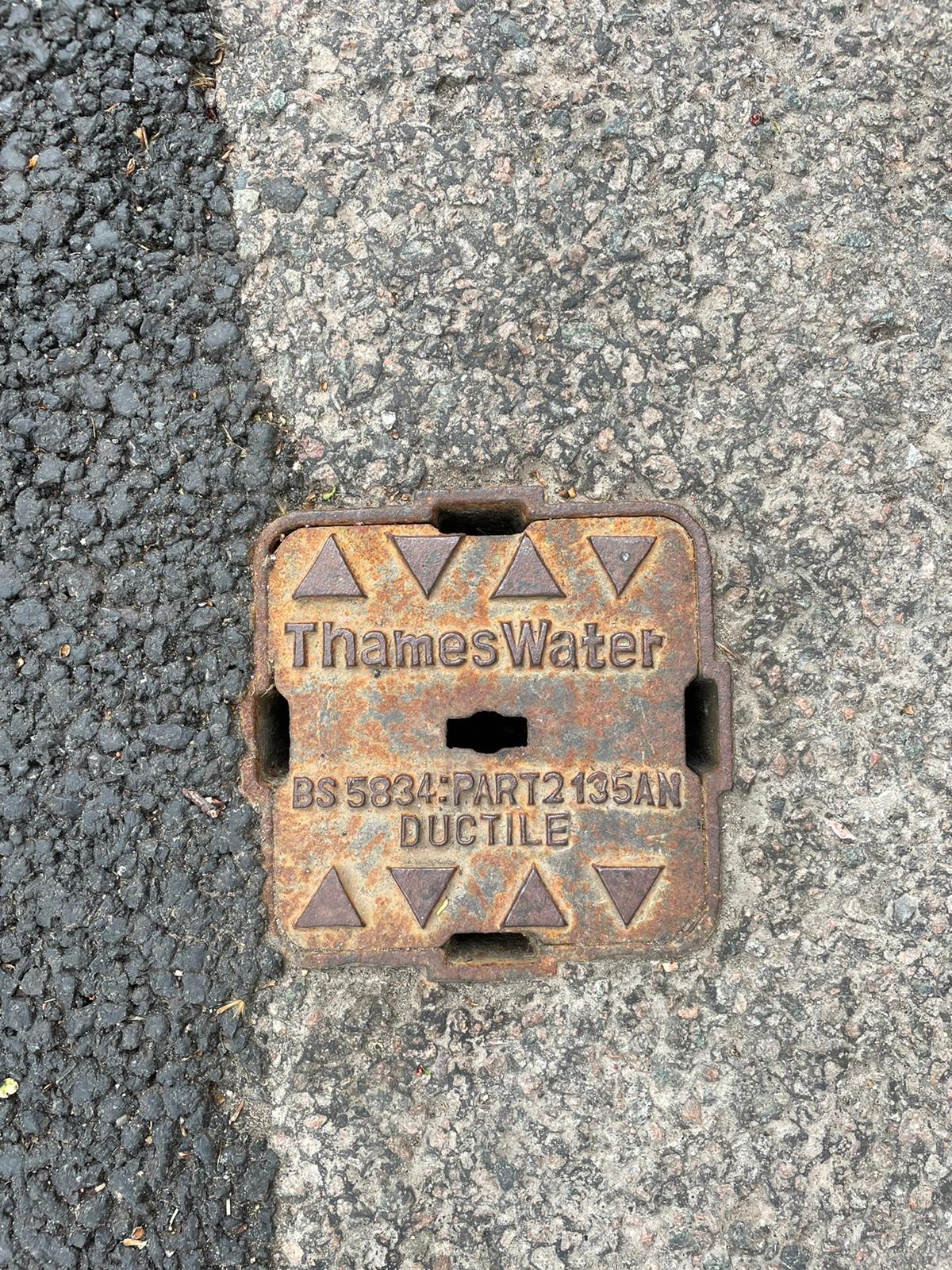
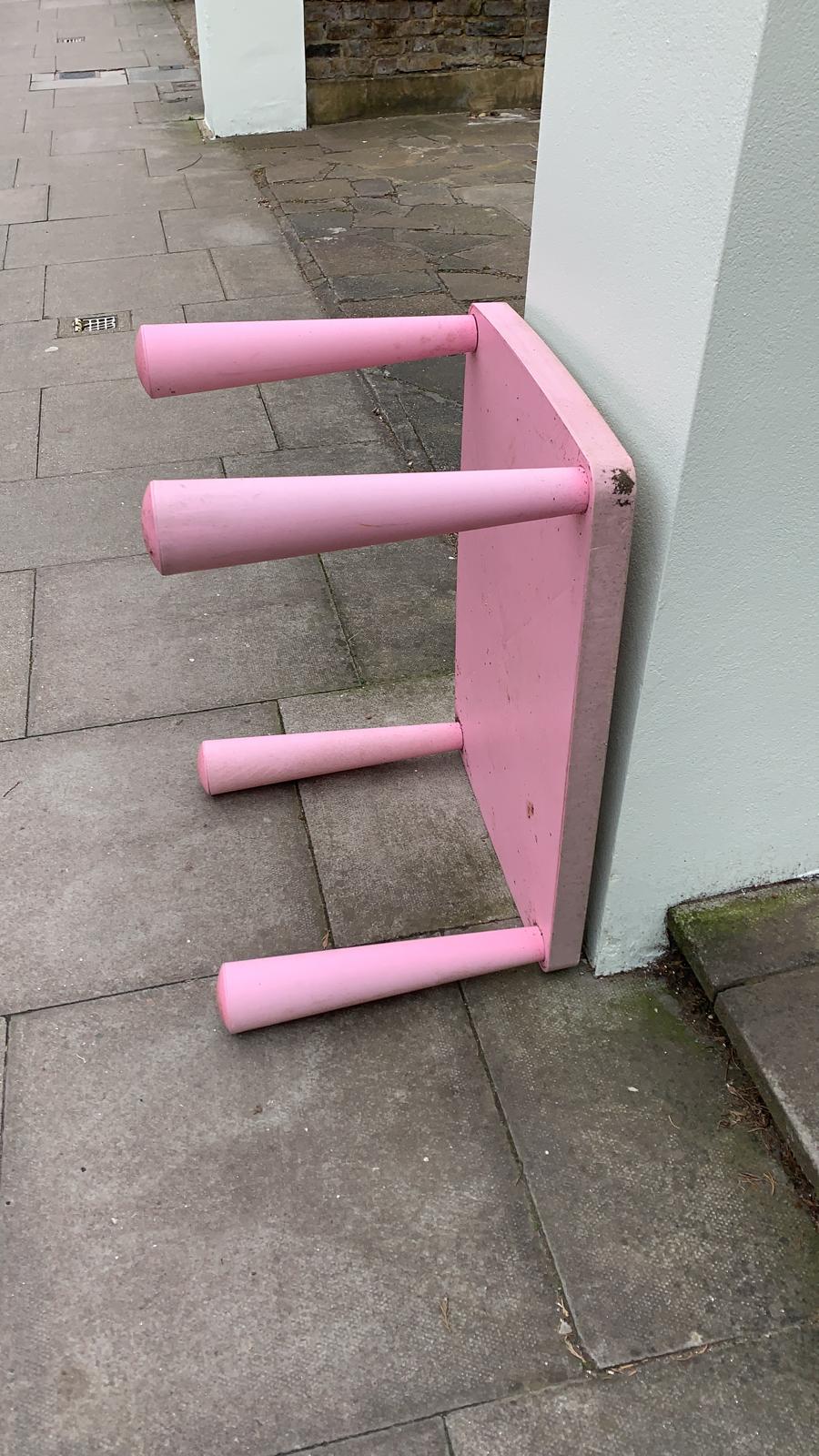


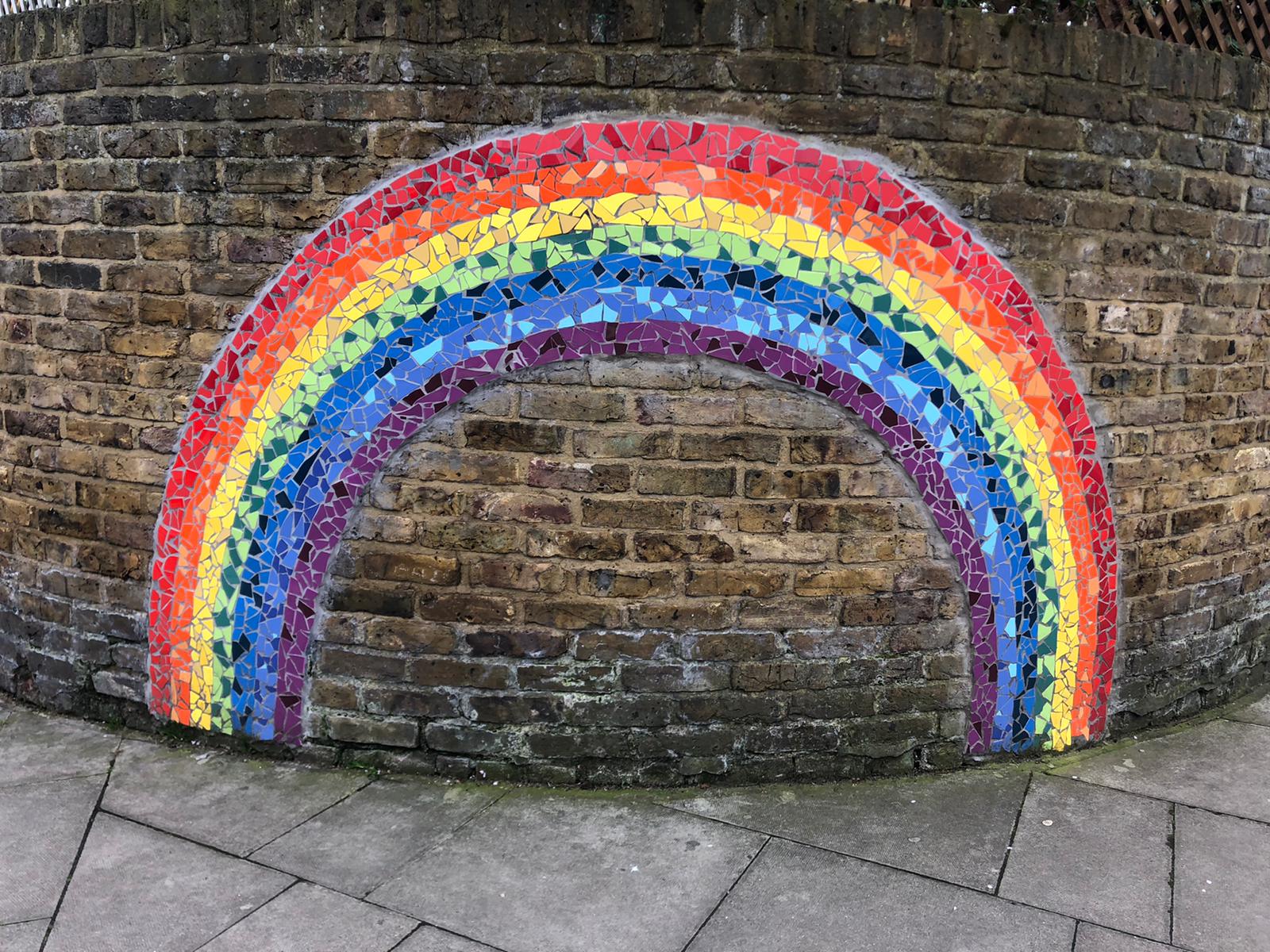


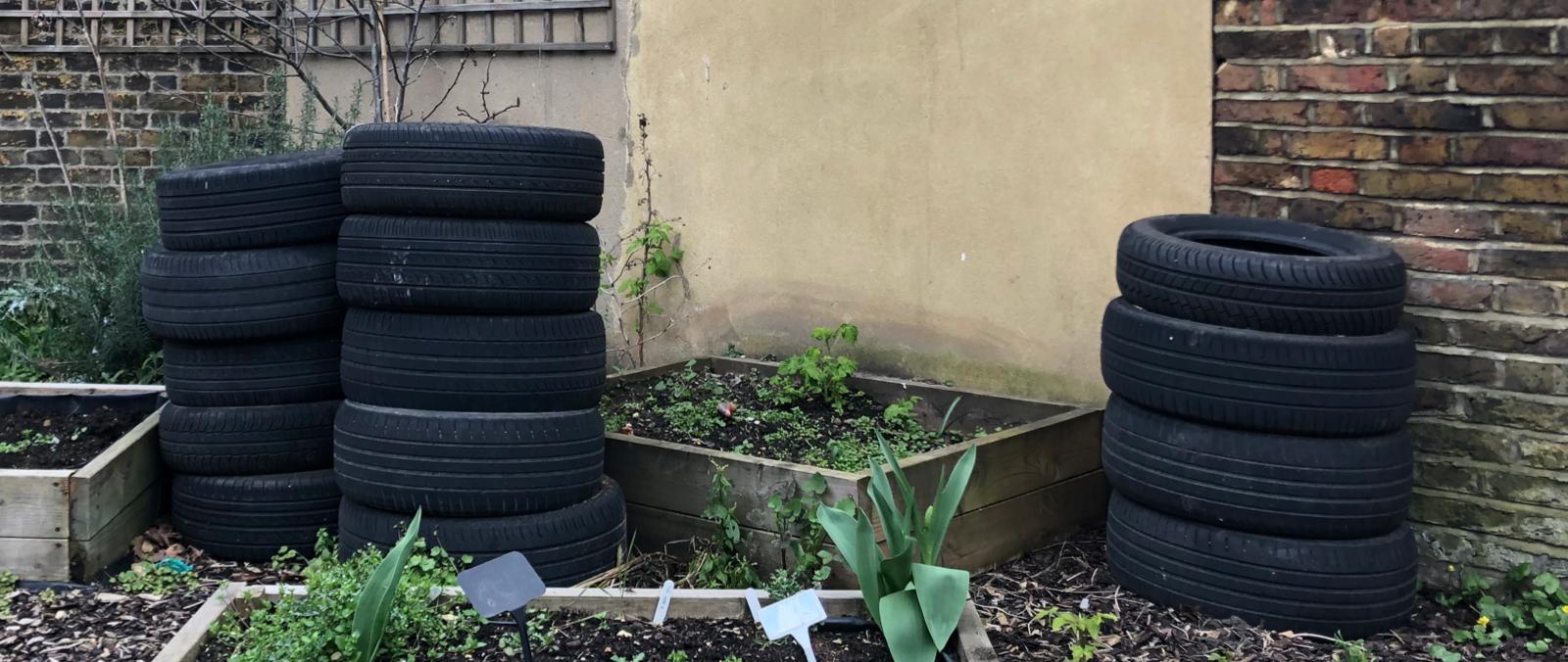




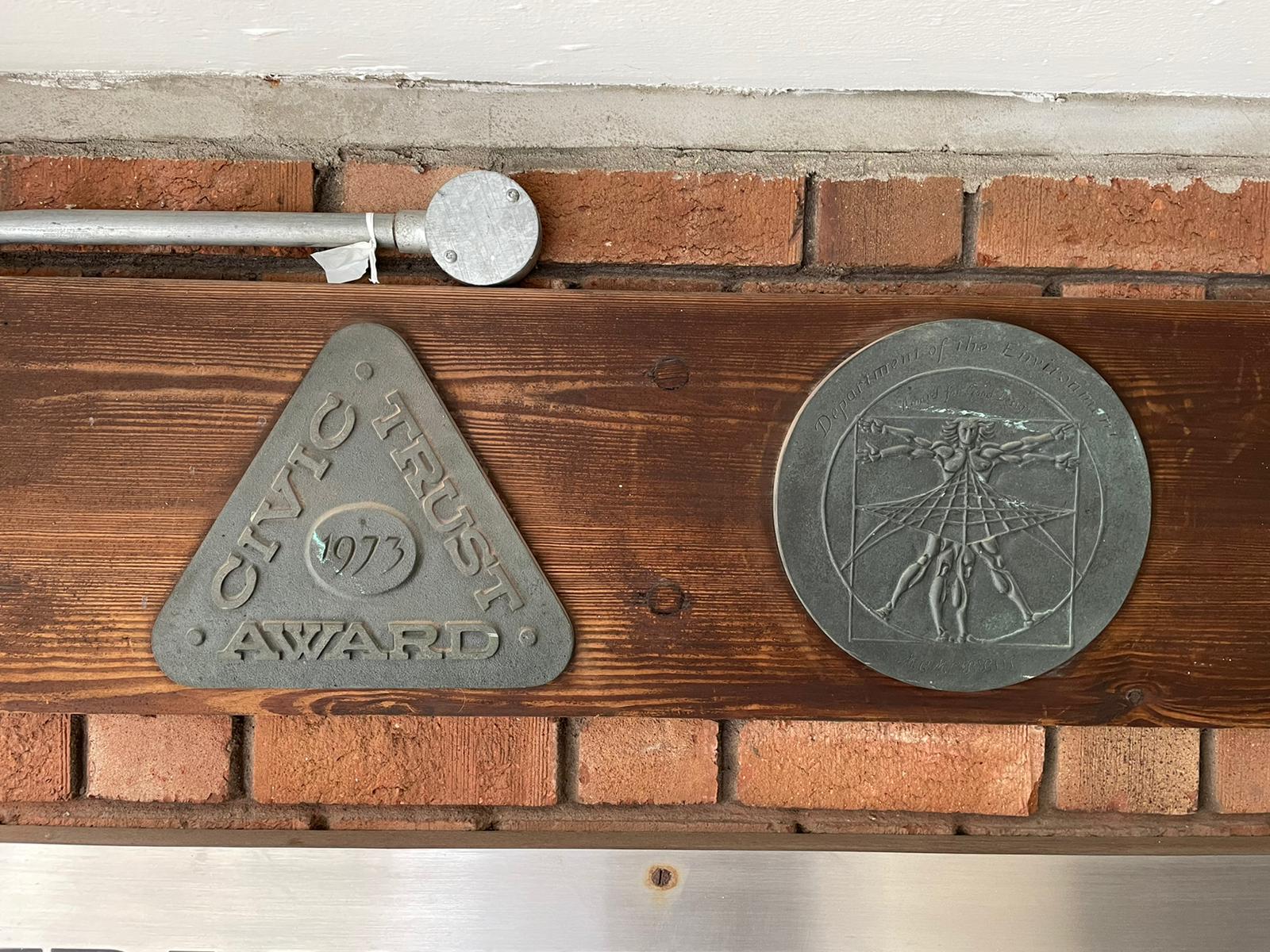


Socially engaged practices during the Covid-19 can be challenging, but I am thrilled that we achieved it. We managed to get to know each other and communicate through collective & individual creative processes. I am grateful that I witnessed this process and had the chance to meet unique and colourful voices, which in the end, united and co-created a beautiful new narrative.
To express my gratitude to the participants, I created and gave to them a tangible souvenir of our collective experience. I designed and printed a small publication that contains:
- An A4 riso-printed brochure with the description of the workshop & the content of the publication.
- An A2 screen-printed poster of the Asemic map of the activity 1 & 2 that took place in the Mural platform.
- An A5 publication(24 meter concertina) of the new narrative that was created in our Whatsapp group chat.
- An A4 clear transparency film, to carry on the activities by themselves.
